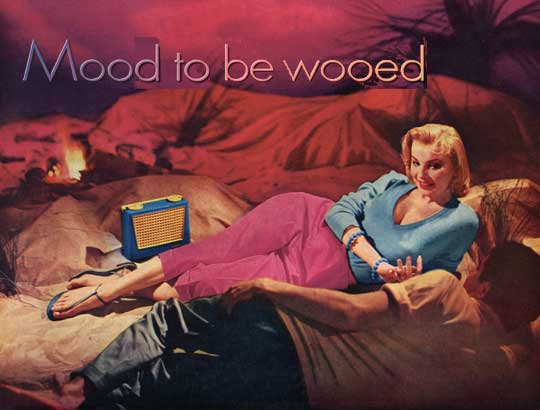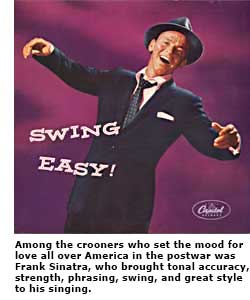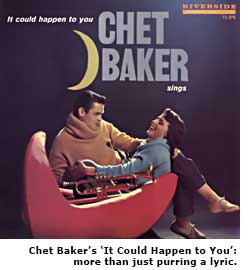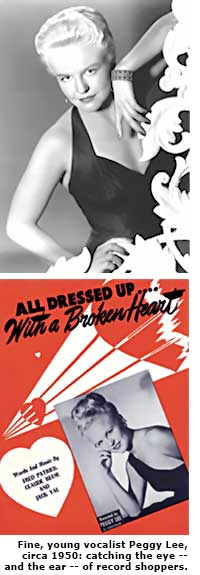Mood to be Wooed - Classic Crooners


When the boys returned home to their girls after fighting World War II, they were very much in the mood for a different kind of boom—from making babies, not from dropping and dodging bombs. In the years that followed, there was a bounty of singers who set the mood for love all over America by romancing melodies and lyrics.
The term 'crooning,' applied to this style of singing, evoked the soothing but sensual sounds that beamed from the country's emerging line of mid-century home electronics—newfangled hi-fi record players, transistor radios, and television sets. Singers got served up, along with cocktails for two, in the intimate setting of the homes Americans were building and buying in record numbers, as well as in the nation's bourgeoning network of cozy nightclubs.
A ban of several years on recording, instigated by the American Federation of Musicians, had ended before the close of the war, but not before it had helped diminish the role of big bands and evolve vocalists from band functionaries to stars in their own right. These new luminaries benefitted from the replacement of the old 78-rpm record by the more durable and cheaper 45-rpm single (which also featured one song per side), as well as the expansive 33-1/3-rpm long-playing (LP) record album, with room for at least a dozen dreamy tunes.

Alluring album covers were an essential ingredient of LP packaging. Fine young vocalists such as Peggy Lee and Julie London also had to look fine to catch the eye of record shoppers. (Check out Ms. London and the period jacket art for her 'Around Midnight' album on this page.) Foxy female models adorned albums by male crooners such as Frank Sinatra, Dean Martin, and Mel Tormé; while Chet Baker, on 'It Could Happen to You, appeared with both horn and honey to show that he could do more than just purr a lyric. It wasn't women's lib, but it was an improvement over the racy, and sometimes racist, association placed on such earlier singers as Bessie Smith and Billie Holiday.
To a degree, Holiday benefitted from the iconic affect of sophistication and virtuosity associated with mid-century female crooners, both white and black, who also included veterans Ella Fitzgerald and Lee Wiley, as well as newer arrivals Sarah Vaughan, Helen Merrill, Chris Connor, Etta Jones, and others. Cut loose from their former big band restrictions, often working with a small ensemble or a single piano accompanist, both women and men found a way to not only look and sound fine, but to croon away the fourth wall that had formerly separated performer from listener.

"You learned how to woo the audience, and have them come to you and have you come to them," reflects Tony Bennett, whose first of many crooned hits for Columbia Records, 'Because of You,' helped usher in the 1950s. "What I found out...is that the more honest you become, the more it becomes a reality and a solid performance. The greatest example was Billie Holiday, or Frank Sinatra. It lasts, it's not something that will just be popular and then be forgotten."
Bennett, now 83 and one of the few mid-century favorites still alive and singing, is quick to point out that the long-lasting appeal of crooning actually predates that period. Bennett's own trademark smoky tone and his personable performance style, he says, were influenced in his youth by 1930s jazz singer Mildred Bailey, who "was nice and sweet and honest." And there was also Bailey's more famous contemporary colleague, Bing Crosby. "I had an Irish aunt and she had every Bing Crosby record, and I used to go over to her house on almost a nightly basis, and we'd just listen to Bing. It was Bing and the art of intimate singing which interested me."
The late Mel Tormé, with Bennett one of the most artful of the mid-century male singers, featured Crosby among "my singing teachers" in his 1994 book of that title. "Before Bing, most singers were stiff and predictable," Tormé writes. "Bing, on the other hand, exuded charm, ease, and a nice tenor quality that instantly endeared him not only to the female population but to a much broader audience that included men as well." Mahalia Jackson, elsewhere in Tormé's book, cites early recording artist and actress Ethel Waters as a vital influence on later women, including Holiday, Fitzgerald, and Vaughan.




